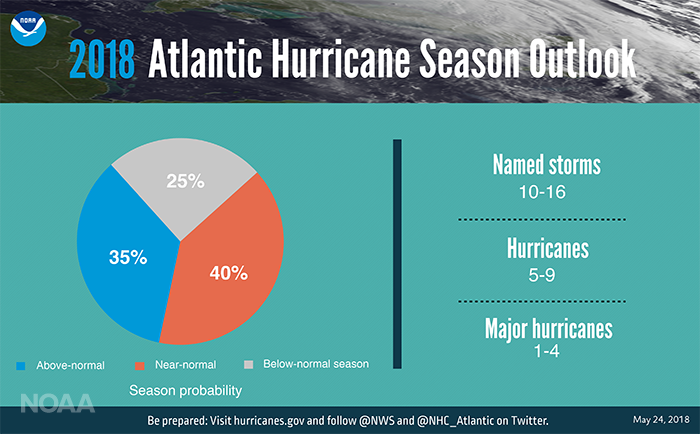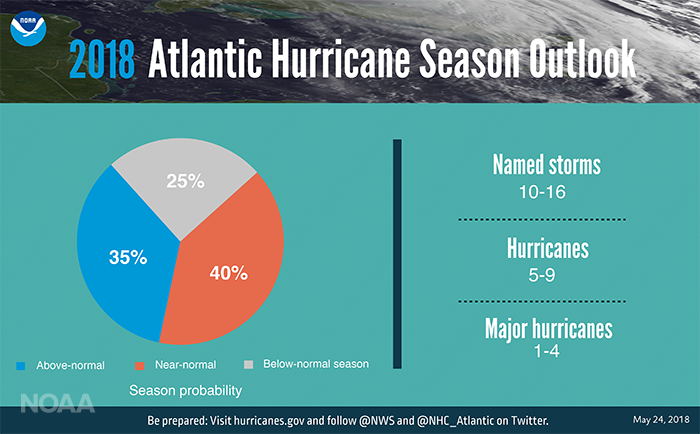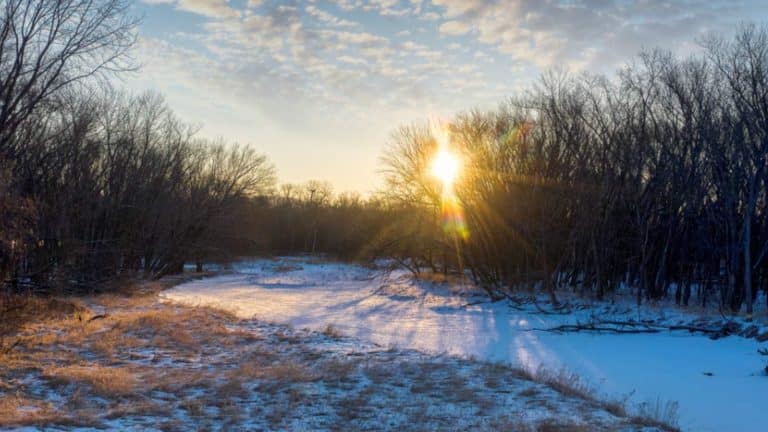 Hurricane season officially begins today and runs through November. This is the six month period when hurricanes typically occur in the Atlantic. Forecasts for the 2018 hurricane season indicate that it will likely be a near-normal year, with neither an exceptionally high or low amount of Atlantic hurricane activity. This may sound like a relief, coming out of the devastating hurricane season last year, which killed hundreds or thousands on the mainland U.S. and in Puerto Rico and caused more than $200 billion in property damage, but it is important to remember that it only takes one bad storm, even in an inactive year, to wreak havoc. For example, Hurricane Andrew was a category 5 hurricane that made landfall near Miami, FL in the midst of an inactive year. And even this potentially near-normal year will unfortunately have plenty of storms to worry about. The National Oceanic and Atmospheric Administration (NOAA) predicts “a 70-percent likelihood of 10 to 16 named storms (winds of 39 mph or higher), of which 5 to 9 could become hurricanes (winds of 74 mph or higher), including 1 to 4 major hurricanes (category 3, 4 or 5; with winds of 111 mph or higher).” For reference, “An average hurricane season produces 12 named storms, of which 6 become hurricanes, including 3 major hurricanes.”
Hurricane season officially begins today and runs through November. This is the six month period when hurricanes typically occur in the Atlantic. Forecasts for the 2018 hurricane season indicate that it will likely be a near-normal year, with neither an exceptionally high or low amount of Atlantic hurricane activity. This may sound like a relief, coming out of the devastating hurricane season last year, which killed hundreds or thousands on the mainland U.S. and in Puerto Rico and caused more than $200 billion in property damage, but it is important to remember that it only takes one bad storm, even in an inactive year, to wreak havoc. For example, Hurricane Andrew was a category 5 hurricane that made landfall near Miami, FL in the midst of an inactive year. And even this potentially near-normal year will unfortunately have plenty of storms to worry about. The National Oceanic and Atmospheric Administration (NOAA) predicts “a 70-percent likelihood of 10 to 16 named storms (winds of 39 mph or higher), of which 5 to 9 could become hurricanes (winds of 74 mph or higher), including 1 to 4 major hurricanes (category 3, 4 or 5; with winds of 111 mph or higher).” For reference, “An average hurricane season produces 12 named storms, of which 6 become hurricanes, including 3 major hurricanes.”
The beginning of the season is a good time to make sure you and your family are prepared for hurricane impacts, should one threaten your area. See hurricane preparedness tips here. But in addition to making sure our households are prepared for the short-term forecast of hurricanes this season, we must also make sure our communities are prepared for the impacts of hurricanes in the long term, by seeking to understand how hurricane risk may change in the years to come and how we can avoid the worst outcomes.
This week, we hosted a webinar with NASA Senior Scientist Timothy Hall, who updated us on the latest scientific understanding of how climate change is already making hurricanes more destructive and how global warming will continue to increase the intensity of hurricanes in the future. You can watch a recording of the full webinar here (also embedded in the last image below), but I’ll try to summarize the main points.
In sum, experts have found that global warming is causing a range of impacts on hurricanes that increase their severity on average. The image on the left shows some of the long term impacts of global warming on hurricanes, ranked by those with the most scientific certainty to those with the least certainty. Let’s discuss the top 3 more certain effects. The source of information in the following paragraphs is Dr. Hall’s presentation, unless otherwise linked.
1. Sea level rise leads to greater storm surge
Global warming causes the sea level to rise through thermal expansion of the water (warmer water means it becomes less dense and rises) and the flow of melting land-based glaciers into the ocean (like adding ice cubes to an already-full glass of water). The global mean sea level has risen about 8 inches over the past century, but global warming is increasing this rate of rise. In recent years, the rate of sea level rise has doubled or tripled and it is expected that global sea levels will rise 1 to 4 feet–but as much as 8 feet–over the course of this century, depending on how swiftly carbon pollution is reduced. When tropical storms or hurricanes arrive onshore, they push water inland, raising the sea level often multiple feet. Storm surge itself can be catastrophic, but storm surge plus a couple additional feet of height added by sea level rise greatly amplifies the destructive potential. As the sea rises from higher temperatures, each storm pushes flood waters higher than it would have without sea level rise. For example, insurance giant Lloyds of London estimated that about 30 percent of the New York City area losses from Hurricane Sandy were attributable to just the historical observed sea level rise. Other scientific analysis has estimated that just 8 inches of historic sea level rise translated to Sandy affecting an additional 27 square miles, hitting 83,000 additional homes. Put another way, the damage from Hurricane Sandy in New York City would have been 30 percent less and tens of thousands of homes would have been spared from flooding in the absence of sea level rise.
2. Warmer air means more rainfall
As the air warms due to greenhouse gas pollution, it is capable of holding more moisture. This means that over time, hurricane events have had larger and larger amounts of water vapor in the air that get turned into rain and result in flooding of our communities. NASA scientist William Lau found that precipitation from tropical cyclones increased 24 percent per decade from 1988 to 2012. A recent illustration of this increased precipitation potential of hurricanes was found in Hurricane Harvey last year, when about 20% of the rainfall that plagued the region was due to warming that has already occurred in the Gulf of Mexico. Increased precipitation combined with the higher storm surge from raised sea levels, means that global warming is already having a significant impact on flooding from hurricanes and will continue to increase in severity in years to come.
3. Warmer oceans increase intensity of hurricanes
As oceans warm, the growing differential between the warmer ocean water and cooler atmospheric air is raising the intensity potential of hurricanes, which can be thought of as their “speed limit.” As this “speed limit” increases, we may see an increase in the frequency of category 4 and 5 hurricanes in the future, and some storms may surpass the intensity of any hurricanes that have ever been measured before. An interesting point is that the overall frequency of all hurricanes (categories 1-5) may decline in the future even as the average strength of the hurricanes increases.
Ask anyone who lives along the coast and they’ll tell you that just one hurricane is bad enough. With global warming increasing the destructive potential of hurricanes, it is time that–just as we prepare our households for disasters to avoid the worst impacts–we also prepare our communities to avert worst-case scenarios by doing our part to stop global warming by reducing our reliance on fossil fuels that emit carbon pollution.



